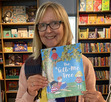The rhyme and the reason: confessions of a picture book author
It’s a well-known fact that we authors spend a lot of time alone, dreaming up and crafting our stories, discarding some and holding on to a golden few. If the idea takes off, we then spend many more hours, days – and often weeks or months – drafting, rewriting, testing, editing and polishing before finally having the courage to put the story out into the big wide world.
It’s a long (long) process – no matter how short the book. Don’t believe anyone who tells you that writing children’s books is the easy option!
The above holds true for middle grade novels (aimed at ages 8-12), for early reader chapter books – and for picture books whose word count is typically around 500 but might range from zero to 1,000. (Less is best. Less is harder! And it goes without saying that the illustrations are crucial.)
[image error]
Ferdinand Fox rhyming picture books
The rhyming game
Trying to squeeze a satisfying and entertaining tale into a picture book’s 26 or 28 pages (this is what’s left after the title and copyright pages etc are used up) is hard enough at the best of times as we toil away on our own. Add in rhyme and you’re into a whole new layer of complexity. Getting the story and the rhyme and the rhythm to cooperate along with the illustrations over a limited page count is one huge challenge!
‘Why on earth would anyone want to write in rhyme?’ you might ask yourself. I’d agree with you there. Except that’s how it came out when I began composing my Ferdinand Fox stories after seeing a beautiful fox trot past me in the mist one November evening. I simply couldn’t express the story in any other way!
Happily, rhyme, it seems, is still what little children love best – or most consistently at least.
Speaking as a parent, I also know that the rhyming stories I shared with my children, such as Hairy MaClary from Donaldson’s Dairy and the others from Lynley Dodd’s wonderful series were firm favourites for me and my husband!
Kids know best
Another well-known fact is that children are the most discerning and honest audience out there – and generally the younger, the more discerning! If they don’t like your story they will let you (or their parents or teachers) know in no uncertain terms 



